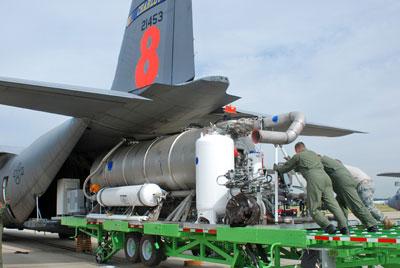Retardant drops from air tankers have become a standard weapon in the fight against large wildfires, such as the Rim Fire affecting a portion of Yosemite National Park and a much larger area of National Forest and private lands.
There's occasional debate about the pros and cons of that technique, but there's no doubting the skill and courage of the crews of those aircraft. Here's a video with a pilot's-eye view of Yosemite during operations over the Rim Fire.
The footage was shot from a C-130J-30 Hercules from the California Air National Guard 146th Airlift Wing. That unit trains for and assists with wildfire suppression activities when civilian contract tankers aren't available.
Aircraft buffs will recognize the venerable C-130, a four-engine workhorse used by the military since the 1950s for a host of tasks, including hauling cargo and troops. When it's time for a fire suppression mission, the aircraft can be fitted with a Modular Airborne Fire Fighting System (MAFFS), a self-contained unit that allows the aircraft to be used as an air tanker against wildfires.
The photos at the left show a MAFFS being loaded into a C-130 by a crew from the North Carolina National Guard, and a plane from the 146th Airlift Wing in Port Hueneme, California, on a mission near Palm Springs, California, on July 19, 2013.
In the following video, radio traffic can be heard between the C-130 crew and the pilot of a smaller and more maneuverable "lead" plane which scouts the route and determines the location for the retardant drop. The C-130 crew can be heard pointing out Yosemite Valley and Half Dome and remarking that this is a "pretty impressive fire."
That description of the fire changes to "That is unreal" at the 4:10 point on the video; at the 5:20 marker, the lead plane is visible just before it releases a smoke marker to show the C-130 pilot where to began his retardant drop.
The pilot in this video may make the job sound and look pretty routine, but flying one of these large aircraft at slow speeds and low altitudes over mountainous terrain—while some of that landscape also happens to be on fire—is anything but easy.
Whether or not you're a fan of the use of aircraft to deliver either water or retardant on large fires, the crews of these missions deserve our appreciation for performing a difficult and dangerous job when they're called upon to do so.


 Support Essential Coverage of Essential Places
Support Essential Coverage of Essential Places







Add comment